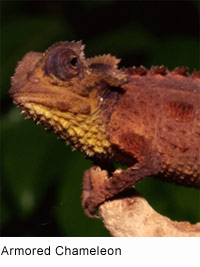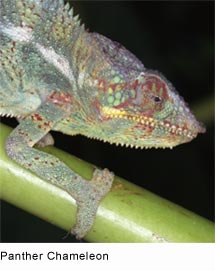|

 Sizes and Scales: Chameleons vary greatly in size and body structure, from the less than 4" Brookesia species, to the 24" Calumma parsonii. There is even one species, thought to be unique to Malawi's Mount Mulanje, that is barely 1.5cm across when fully grown. Sizes and Scales: Chameleons vary greatly in size and body structure, from the less than 4" Brookesia species, to the 24" Calumma parsonii. There is even one species, thought to be unique to Malawi's Mount Mulanje, that is barely 1.5cm across when fully grown.
Festive Faces: Many have head or facial ornamentation, be it nasal protrusions or even horn-like projections in the case of Chamaeleo jacksonii, or large crests on top of their head, like Chamaeleo calyptratus.
Sizes and Sexes: Many species are sexually dimorphic, and males are typically much more ornamented than the females.
Eyes, Tongue, Ears, and Toes: The main things chameleon species do have in common is their foot structure, their eyes, their lack of ears, and their tongue.
Divided Digits: Chameleons have feet that are split into two main "fingers", with a soft pad in between. These "fingers" are equipped with sharp claws to gain traction on surfaces such as bark when climbing. An interesting fact about chameleons is that they have two claws on the outside of their front foot and three on the inside, yet on the back foot this is reversed.
 Incredible Eyes: Their eyes are the most distinctive among the reptiles. The upper and lower eyelids are joined, with only a pinhole large enough for the pupil to see through. Incredible Eyes: Their eyes are the most distinctive among the reptiles. The upper and lower eyelids are joined, with only a pinhole large enough for the pupil to see through.
They can rotate and focus separately to observe two different objects simultaneously.
It in effect gives them a full 360 degree arc of vision around their body. When prey is located, both eyes can be focused in the same direction, giving sharp stereoscopic vision and depth perception.
Hard of Hearing: They lack a vomeronasal organ. Like snakes, they don't have an outer or a middle ear and seem to be deaf; at least they cannot detect airborne sounds. But some, maybe all, can communicate via vibrations that travel through solid material like branches.
Tons of Tongue: Chameleons have incredibly long tongues (sometimes longer than their own body length) which they are capable of extending out of the mouth at a rapid rate. It has a sticky tip on the end which serves to catch prey items that they would otherwise never be able to reach with their lack of locomotive speed. The tongue's tip is a bulbous ball of muscle, and as it hits its prey, the tongue rapidly forms a small suction cup. Once the tongue sticks to a prey item, it is drawn quickly back into the mouth, where the chameleon's strong jaws crush it and it is consumed. Even a small chameleon is capable of eating a large locust or mantis.


Where in the World? The main distribution of chameleons is Africa and Madagascar, and other tropical regions, although some species are also found in parts of southern Europe, Sri Lanka, India and Asia Minor. There are introduced, feral populations of veiled and Jackson's chameleons in Hawaii and isolated pockets of feral Jackson's chameleons have been reported in California and Florida.
All in the Family: Different members of this family inhabit all kinds of biotopes like tropical and montane rain forests, savannas and sometimes semi-deserts and steppes. Chameleons are mostly arboreal and are often found in trees or occasionally on smaller bushes. Some smaller species, however, live on the ground under foliage. The chameleon is "battling" humans for their space and habitat.

What's for Dinner? Chameleons generally eat locusts, mantids, crickets, and other insects, but larger chameleons have been known to eat small birds. However, contrary to popular belief, most full grown chameleons tend not to eat flies. A few species, such as Chamaeleo calyptratus have been known to consume small amounts of plant matter. Chameleons prefer running water to still water.
 Color Communication: Some chameleon species are able to change their body color, which has made them one of the most famous lizard families. Color Communication: Some chameleon species are able to change their body color, which has made them one of the most famous lizard families.
Contrary to popular belief, this change of color is not purely an adaptation to the surroundings (although the surroundings play a large part) but also an expression of the physical and physiological condition of the lizard.
The skin color is changed under influence of mood, light, and temperature. The skin color also plays an important part in communication and rivalry fights.
Color Decoded: Chameleons have specialized cells, collectively called chromatophores, that lie in layers under their transparent outer skin. The cells in the upper layer, called xanthophores and erythrophores, contain yellow and red pigments respectively.
 Below these is another layer of cells called iridophores (or guanophores), and they contain the colorless crystalline substance guanine. These reflect amongst others the blue part of incident light. If the upper layer of chromatophores appear mainly yellow, the reflected light becomes green (blue plus yellow). Below these is another layer of cells called iridophores (or guanophores), and they contain the colorless crystalline substance guanine. These reflect amongst others the blue part of incident light. If the upper layer of chromatophores appear mainly yellow, the reflected light becomes green (blue plus yellow).
A layer of dark melanin containing melanophores is situated even
deeper under the reflective iridophores.
The melanophores influence the 'lightness' of the reflected light. All these different pigment cells can rapidly relocate their pigments, thereby influencing the color of the chameleon.

Birds and Bees: Most chameleons lay eggs, which lie buried for up to 9 months before hatching. Newborn chameleons are surprisingly independent, due to the fact that their parents will have moved away from the clutch long before its hatching. Some species, like Chameleo jacksonii give live birth. Clutch size varies greatly between species, smaller chameleons typically have smaller litters. The young grows on its own.

All text is available under the terms
of the GNU Free Documentation License
|